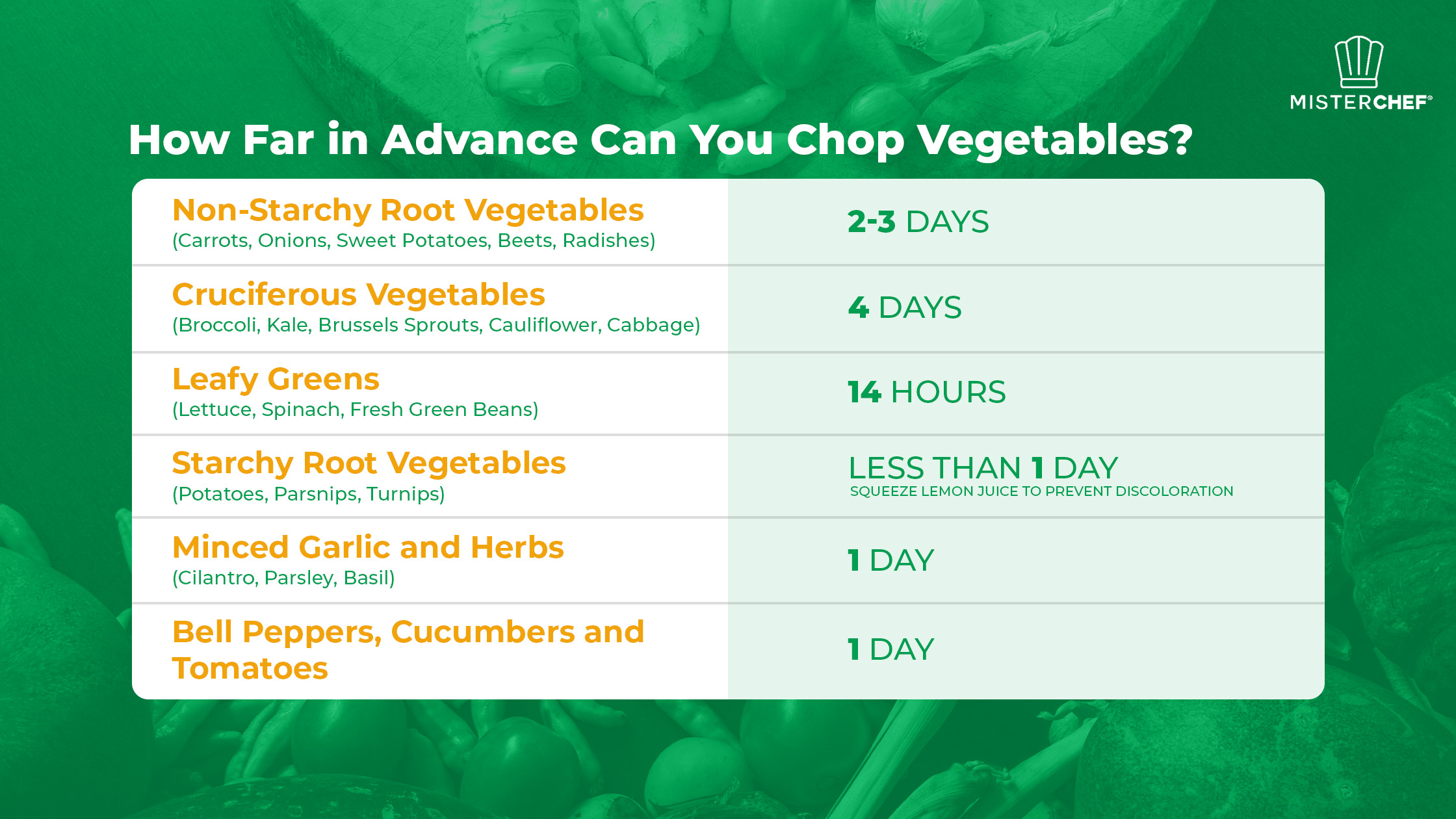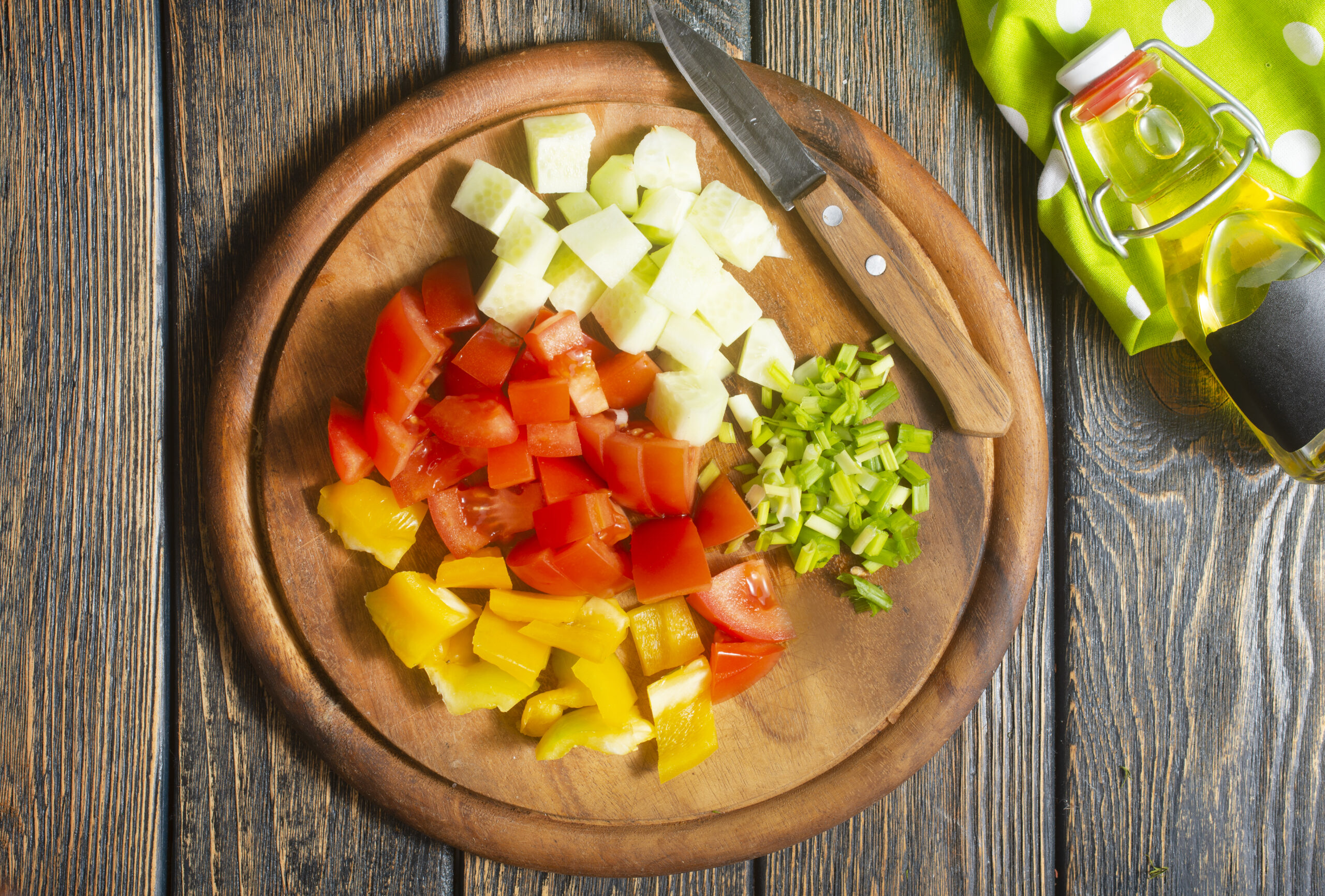If you have a big event coming up where you need to serve a whole bunch of people, then having some pre-prepped veggies can be a huge time saver. But how far in advance can you cut your veggies so that they’re still fresh for use? Read on to find out.
How Far in Advance Can You Chop Vegetables?

This will depend on the type of vegetables you plan to cut. Here’s a general guideline:
Non-Starchy Root Vegetables (Carrots, Onions, Sweet Potatoes, Beets, Radishes)
These can be peeled and chopped 2-3 days in advance without oxidizing, losing moisture, or spoiling. For beets, carrots, radishes, sweet potatoes, etc, you can simply cut them as you wish, and store them in an airtight container. For onions, wrap the cut ones in aluminum foil or plastic wrap before putting them in the container to prevent a strong oniony smell from accumulating in the fridge.
Cruciferous Vegetables (Broccoli, Kale, Brussels Sprouts, Cauliflower, Cabbage)
Cruciferous vegetables like broccoli, Brussels sprouts, kale, cauliflower, and cabbage are considered to be some of the hardiest vegetables, which is why you often see them pre-cut and packaged in grocery stores. They can be cut at least 4 days in advance. When storing them, store the cut vegetables in a container or plastic bag in the refrigerator. If they start to look dry, lightly sprinkle them with water.
Leafy Greens (Lettuce, Spinach, Fresh Green Beans)
Unlike cruciferous vegetables, leafy greens are among the most delicate vegetables. Once cut, they easily bruise, and their edges can turn mushy in just a few hours. It’s best to cut these veggies as close to the event as possible, preferably within 14 hours. To prevent them from wilting, store them in a plastic bag with a paper towel to absorb excess moisture. Also, use a sharp knife when cutting to avoid bruising. Hardier greens like kale, beet greens, etc can be cut and stored 2 to 3 days in advance.
Starchy Root Vegetables (Potatoes, Parsnips, Turnips)
Although non-starchy root vegetables will hold up days in advance, starchy ones are more susceptible to oxidization. You’ve probably seen this happening when cutting a potato and how it turns black within hours. This is due to being exposed to oxygen in the air. It’s best to cut these vegetables on the day of the event. If you do plan on cutting them a couple of hours in advance, squeeze some lemon juice over them to prevent discoloration.
Minced Garlic and Herbs
Garlic and herbs like cilantro or parsley should be cut one day in advance. Make sure to store them in a small, tightly sealed container in the refrigerator so they don’t lose flavor. Do not store minced garlic in olive oil as it’s classified by the USDA as a salmonella risk.
Bell Peppers, Cucumbers and Tomatoes
These should ideally be chopped the day of your event to maintain their best texture and moisture levels. If you need to cut them a day ahead, keep them in an airtight container in the fridge and drain any excess liquid before use.
Can the Cutting Technique Affect Shelf Life?
Yes, it can. For instance, larger cuts of vegetables will stay fresh longer than finely chopped ones because they have less exposed surface area. So, if you’ve finely chopped your veggies into julienne or matchstick cuts for a stir fry, be cautious not to store them for more than 24 hours.
How to Prep Veggies for Storage

Here are detailed steps to ensure your veggies stay fresh in storage:
Step 1: Clean and Dry Thoroughly
Always start by washing your vegetables under cold water. This removes any dirt and bacteria that might cause them to spoil faster. For root vegetables, use a brush to scrub off any soil. After washing, dry thoroughly with a clean towel or let the veggies air dry.
Step 2: Use Airtight Containers
Store your cut vegetables in airtight containers or resealable plastic bags. Make sure to store different types separately. For example, ethylene-producing vegetables like tomatoes can cause others like greens to spoil faster, so they should be stored apart.
Step 3: Control Humidity
Some vegetables, like leafy greens, benefit from a bit of moisture to keep them fresh. You can add a damp paper towel inside the container to maintain humidity. Alternatively, vegetables like peppers and carrots should be stored in a dry environment.
FAQs
Can I chop vegetables and leave them at room temperature?
It’s not recommended to leave chopped vegetables at room temperature as this can lead to bacterial growth and spoilage. Always refrigerate chopped vegetables promptly.
Can I freeze chopped vegetables for later use?
Yes. However, freezing can affect the texture of some vegetables, so it’s best to blanch them before freezing. Be sure to use freezer-safe containers or bags and label them with the date.
How can I tell if chopped vegetables have gone bad?
If the vegetables appear slimy, discolored, or have a foul odor, it’s probably spoilt and should be discarded.
Summary
While it’s best to chop vegetables on the same day you plan to use them, you can prepare certain vegetables in advance with proper storage techniques. By following the guidelines outlined in this blog, you can simplify your meal prep vegetables process.
To simplify your chopping process even further, consider the MisterChef Mini Food Chopper. This handy tool allows you to chop vegetables quickly and uniformly, saving you time and effort in the kitchen. Shop with us today.







